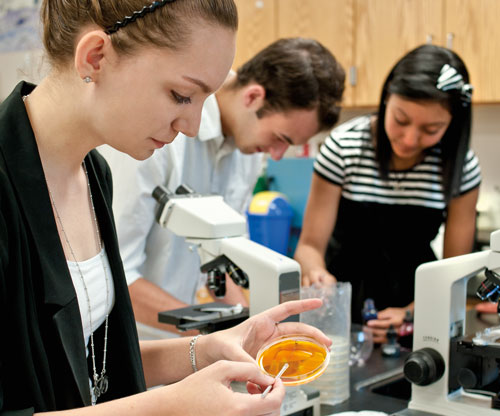Infectious Future
Postgrads bring microbiology to
high school
It wasn’t long ago that Betty Duran, a junior at San Antonio’s John Jay High School, had no idea what microbiology was. But after a science fair project on the topic and a little help from some UTSA students, she has decided it may very well be her career pursuit.
The 17-year-old enrolled in her school’s increasingly popular medical microbiology class, in which UTSA master’s and doctoral students help high school students to study microscopic organisms and their role in human illnesses.
She was excited about being exposed to an area of biology that fascinates her but which she might not otherwise have come to learn about, she said.
The high school class is part of a five-year, $4.6 million program that is funded by the Department of Defense and managed by UTSA’s South Texas Center for Emerging Infectious Diseases. The center was established to focus state and national attention on the university’s research in molecular microbiology, immunology, microbial genomics, biodefense and other areas of biological research. It leverages established faculty and utilizes their expertise in the various research areas through the recently created Center for Excellence in Infection Genomics.
Since fall 2012, the program has provided everything from texts and educational materials to microscopes, petri dishes and other laboratory supplies to Duran’s school and another local high school, Edison. The program administrators create the curriculum that the high school teachers follow. Throughout the semester, UTSA students supplement that curriculum with guest lectures and lessons.
It is intended to expose more high school students to the laboratory experience and encourage them to pursue post-graduate microbiology degrees, said program administrator Raquel Shrager.
The program also provides grant and scholarship opportunities so that participating high school students’ college education, from undergraduate to doctoral degree programs, can be totally financed.
UTSA students and faculty benefit, too. The program pays them to teach and mentor the high school students.
As part of the curriculum, the high school students are assigned a case history. During the course of the semester-long class, their job is to find the disease that is afflicting their theoretical patient and devise a treatment plan.
Through this exercise, the students get a hands-on feel for the kinds of research a professional microbiologist conducts in the laboratory.
For another of the program’s coordinators, Jesus Romo, the unique project was both a way to help him attain his Ph.D. and an avenue for providing career guidance to dozens of students.
"I am fascinated by how things work, and I try and transfer that to the students because they are the next wave of scientists, and all future discoveries will be in their hands," Romo said.
High school students are at a stage in their lives where they are naturally curious, he said.
"These students, the vast majority of whom are [racial] minorities, might not have otherwise been exposed to this new field of study, and it is exciting to see them getting so stimulated about what they are learning in class."
The popularity of the medical microbiology class has grown so much that John Jay administrators plan to double the number of students in the class next year, and university officials are planning to expand the program by offering the class to other area school districts, Shrager said.
"The more high school biology teachers we get involved and exposed to this microbiology project, the more students those teachers will be able to reach, which will mean that many more students get an opportunity to go to college," she said.
–Guillermo Garcia

